How T-Shirts Became a Patriotic Symbol: From Military Origins to Veterans Day
Discover how T-shirts evolved from military origins into a patriotic symbol. Learn how they honor veterans, celebrate freedom, and express national pride.
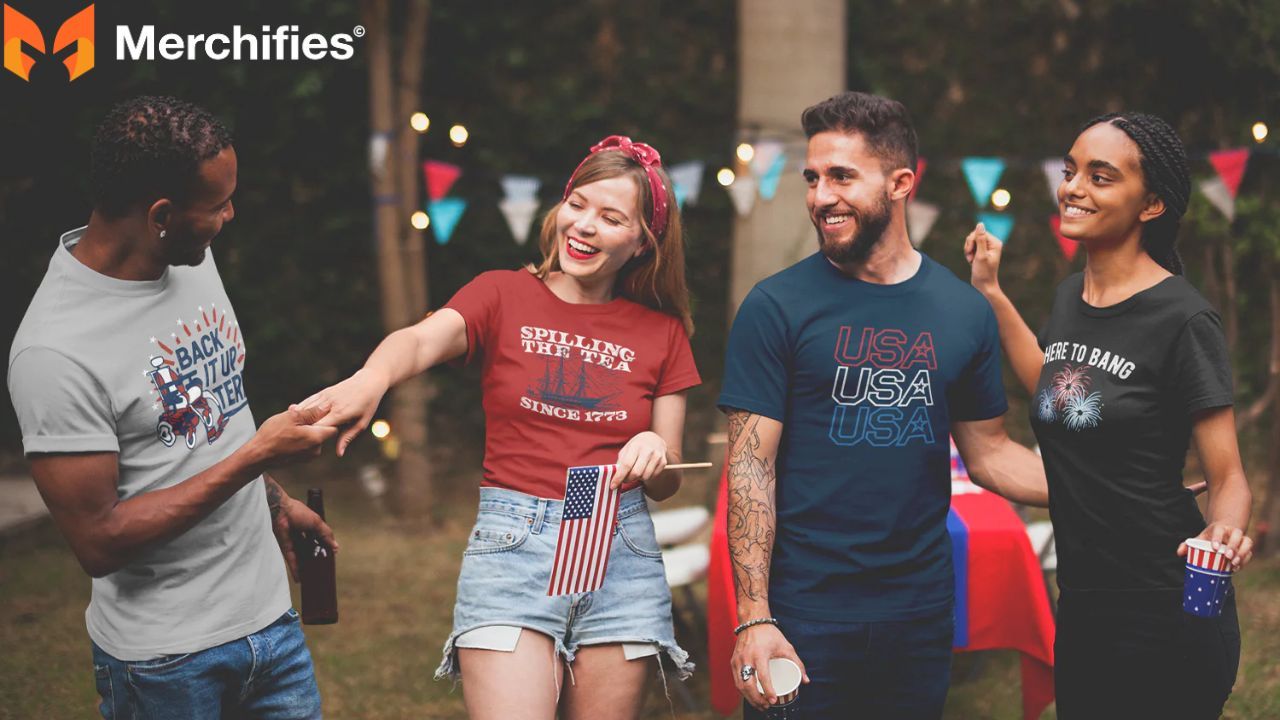
Blog Post Contents
Veterans Day parade. T-shirts everywhere. American flags. Military emblems. "Land of the Free Because of the Brave."
Why t-shirts?
T-shirts became America's patriotic symbol because the military invented them. They evolved through wars. They survived controversy. They're now how Americans wear their patriotism.
This is the story of how t-shirts became a patriotic symbol—and what Veterans Day shirts mean today.
Military Invented the T-Shirt
T-shirts started as underwear. Nothing fashionable. Just functional.
The U.S. Navy changed that in 1913. They made white cotton t-shirts official underwear for sailors. Navy specs created the design you wear today—short sleeves, crew neck, the T-shape.
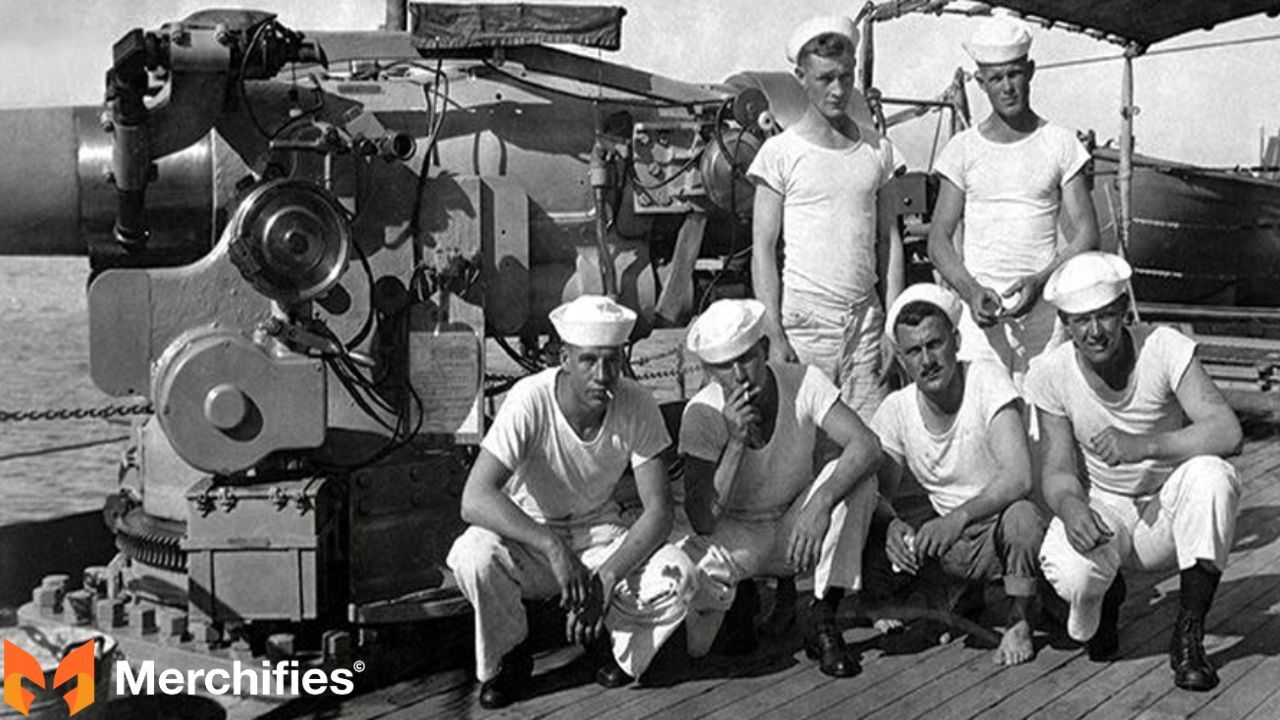
World War I made t-shirts visible. American soldiers saw Europeans wearing them as regular clothing. Comfort mattered in trenches. Soldiers wore t-shirts during training, in heat, around barracks
Veterans brought t-shirts home. After years wearing them in service, they kept wearing them as civilians.
World War II sealed the deal. 16 million Americans served. Millions of t-shirts issued. Life magazine published photos of soldiers in t-shirts. When America saw heroes wearing them, t-shirts stopped being underwear.
This military origin explains everything. T-shirts honor veterans appropriately because t-shirts ARE military heritage. The military invented the garment. Now the garment honors the military.
Hollywood added the final piece. Marlon Brando in 1951. James Dean in 1955. They made t-shirts cool. Military origins gave credibility. Hollywood gave cultural status.
By 1960, t-shirts transformed from military underwear to American icon.
How American Patriotism Evolved on Clothing
Patriotic clothing existed before t-shirts.
Revolutionary War colonists wore homespun rejecting British imports. Political protest through clothing. Civil War brought the first American flag on clothing. Union supporters wore stars and stripes. Your clothing showed which side you chose.
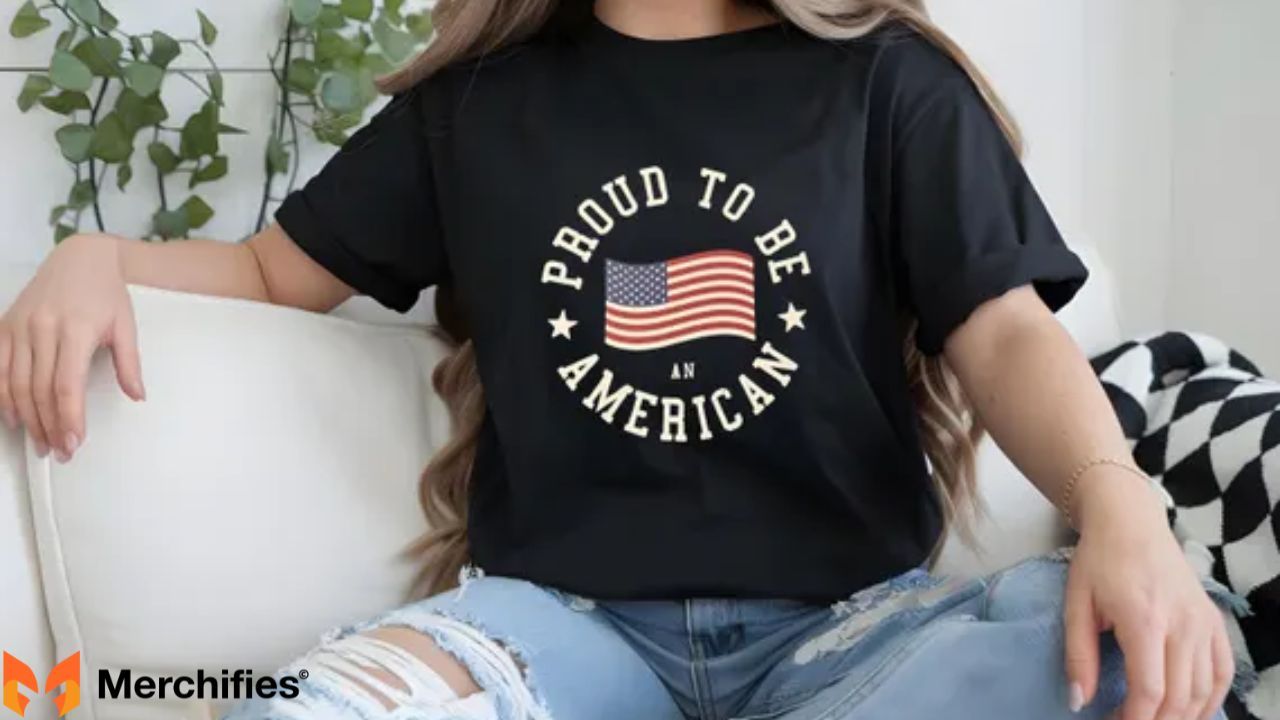
World Wars intensified everything. WWI citizens wore flag pins showing support. WWII took it further—women in factories wore patriotic headscarves, children wore symbols to school. Wearing the flag meant participating in victory.
But patriotic symbols appeared on dresses, suits, pins, hats—not t-shirts yet. T-shirts were still underwear. Technology hadn't advanced enough.
The 1960s changed everything. Vietnam War divided America. Flag t-shirts appeared for the first time at scale. Screen printing technology finally made it possible.
Pro-military Americans wore them supporting troops. Anti-war protesters wore them questioning policy. Same garment. Opposite meanings. Context determined interpretation.
Vietnam veterans reclaimed the symbol. Returning to hostile reception, they wore military shirts forcing visibility. Unit t-shirts. Branch emblems. Flag shirts saying "I served. I deserve recognition."
The 1980s commercialized patriotic apparel. Corporate America discovered Americans would pay to display patriotism. Gulf War 1991 triggered massive surge. "Support Our Troops" appeared on millions of shirts.
September 11, 2001 changed everything permanently. Within days, flag t-shirts became national uniform. "United We Stand" dominated. The shift happened overnight—from holiday-only to everyday wear.
Before 9/11: patriotic shirts three times yearly. After 9/11: acceptable any day.
Wars in Afghanistan and Iraq lasted decades. "Support our troops" became permanent. Veteran-owned companies emerged—Grunt Style, Nine Line. Social media amplified visibility.
Today's patriotic t-shirt culture represents centuries of evolution. The principle stayed constant—clothing expresses loyalty. The medium evolved—t-shirts replaced ribbons and pins. Everyone can participate.
The Art of Patriotic T-Shirt Design
T-shirt designs evolved from simple to sophisticated.
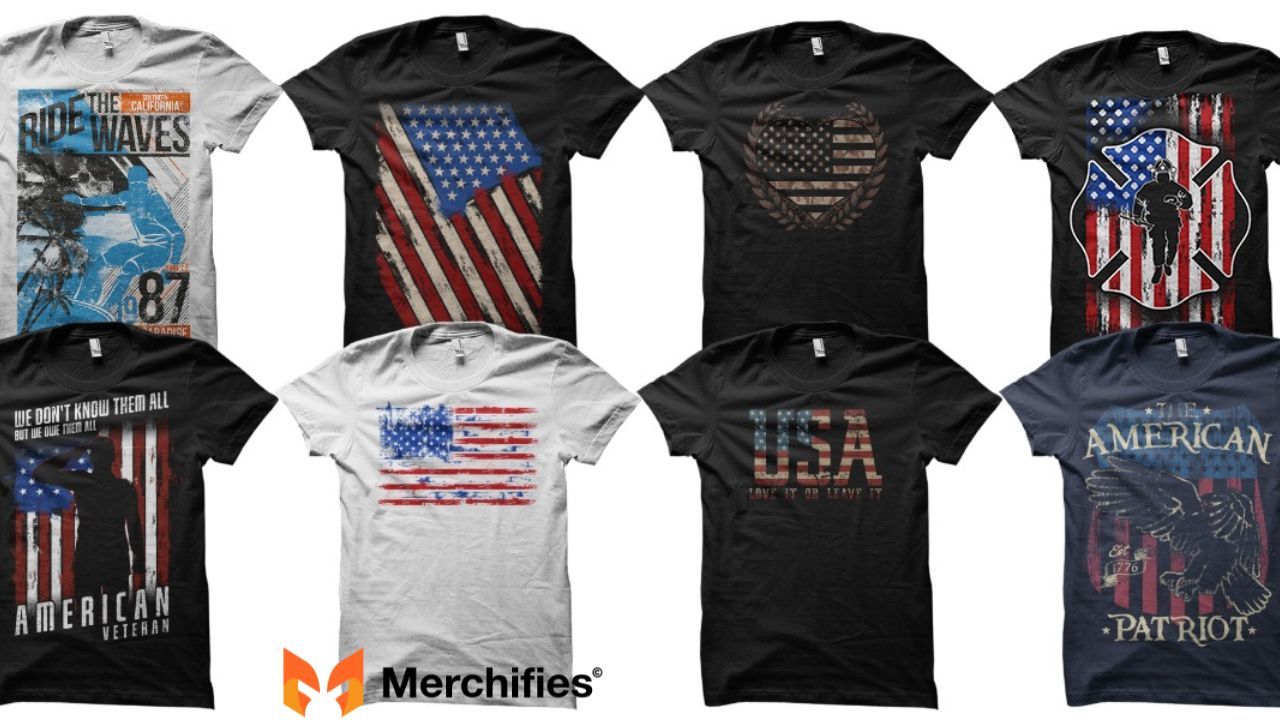
Early designs were basic. A flag. Text saying "USA." Simple graphics. Limited colors. Technology restricted creativity
Modern printing changed everything. Screen printing improvements, direct-to-garment printing, sublimation—enable photorealistic images, unlimited colors, intricate details.
Artists incorporated iconic landmarks. Statue of Liberty. Mount Rushmore. Washington Monument. These symbolize freedom, democracy, the American dream.
Historical figures found permanent places. Abraham Lincoln. Martin Luther King Jr. Founding fathers. Military heroes. Each adds depth—patriotism about people who shaped the nation.
Quotes became artistic elements. "United We Stand" in bold typography. "Land of the Free Because of the Brave" integrated into flags. Constitution excerpts. Typography became art. Font choices convey meaning.
Military-inspired designs created their own category. Vintage military aesthetic—distressed textures, faded colors, aged appearance. Dog tags. Military equipment silhouettes. Unit patches reimagined artistically.
Eagles became central. The national symbol appears in countless variations—realistic renderings, stylized graphics, abstract interpretations. Eagles in flight. Eagles clutching flags. Eagles with military imagery.
Colors carry meaning. Red represents valor and sacrifice. Blue symbolizes loyalty. White signifies purity. Gold indicates excellence. Designers use color psychology deliberately.
Vintage aesthetics gained popularity. Designs mimicking 1940s-1960s style. Retro typography. Faded colors. Worn textures. These tap nostalgia for periods perceived as more unified.
The artistry transformed patriotic t-shirts from political statements to legitimate fashion. You can wear them in more contexts because they're aesthetically sophisticated.
T-Shirts in Political Movements
T-shirts became powerful political tools because they're visible, affordable, accessible.
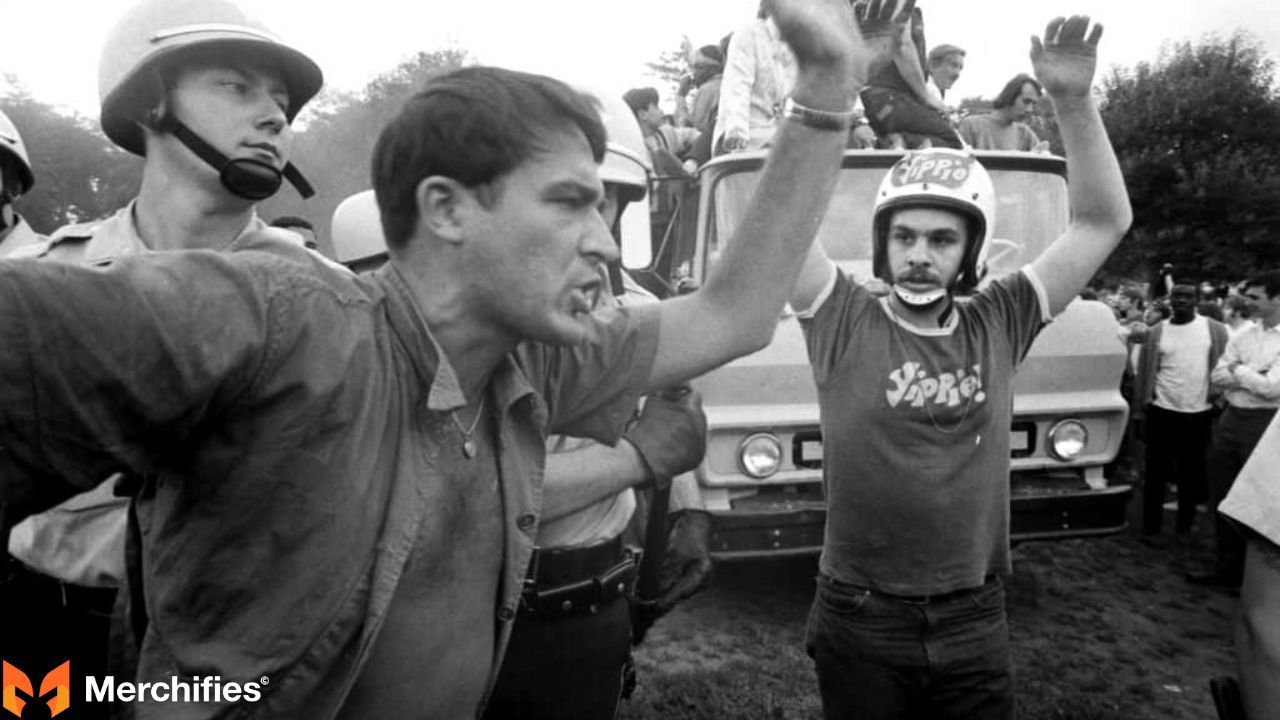
Civil Rights Movement showed potential. "I AM A MAN" on shirts during Memphis strike 1968. Simple text. Powerful statement. Made invisible workers visible.
Anti-war movements during Vietnam used t-shirts heavily. Peace symbols became movement uniform. The t-shirt became walking billboard. You couldn't ignore someone's position when written on their chest.
Political campaigns discovered t-shirts as mobile advertisements. Supporters wearing candidate names became common. The shirt shows personal support while advertising to others.
Veterans Day and military appreciation rely heavily on t-shirts. "Thank You for Your Service" lets civilians display gratitude. Veterans wearing unit shirts maintain identity. Gold Star families honor fallen loved ones.
Recent social justice movements used t-shirts extensively. "Black Lives Matter" made movement visible everywhere. Pride shirts. Immigration reform shirts. Environmental causes.
T-shirts enable continuous advocacy. Rally signs work at rallies. T-shirts work everywhere—grocery stores, schools, workplaces. The message travels with the wearer.
For veterans specifically, t-shirts provide voice. Many struggle articulating experiences. A shirt saying "22 a Day" (veteran suicide rates) communicates crisis without explanation. "Hire Vets" advocates for employment. "PTSD Is Real" raises awareness.
Freedom of speech manifests through t-shirts. Wearing political messages exercises First Amendment rights. The shirt becomes wearable liberty.
Patriotic t-shirts navigate interesting space. They can be neutral—supporting veterans without party affiliation. They can signal political positions—certain slogans associate with ideologies. The wearer controls meaning through context.
T-shirts preserve movement history. Vintage civil rights shirts document struggle. Vietnam protest shirts show resistance. Each becomes historical artifact. Museums collect them. Historians study them
Despite limitations—oversimplifying complex issues—t-shirts remain crucial in American political expression. They're democratic, visible, durable, personal.
For Veterans Day specifically, t-shirts let non-veterans participate meaningfully. You can't serve if you didn't. But you can wear a shirt showing appreciation. The shirt bridges civilian-military gap.
Veterans Day Shirts: What They Mean
Veterans Day shirts carry different meanings depending on who wears them.
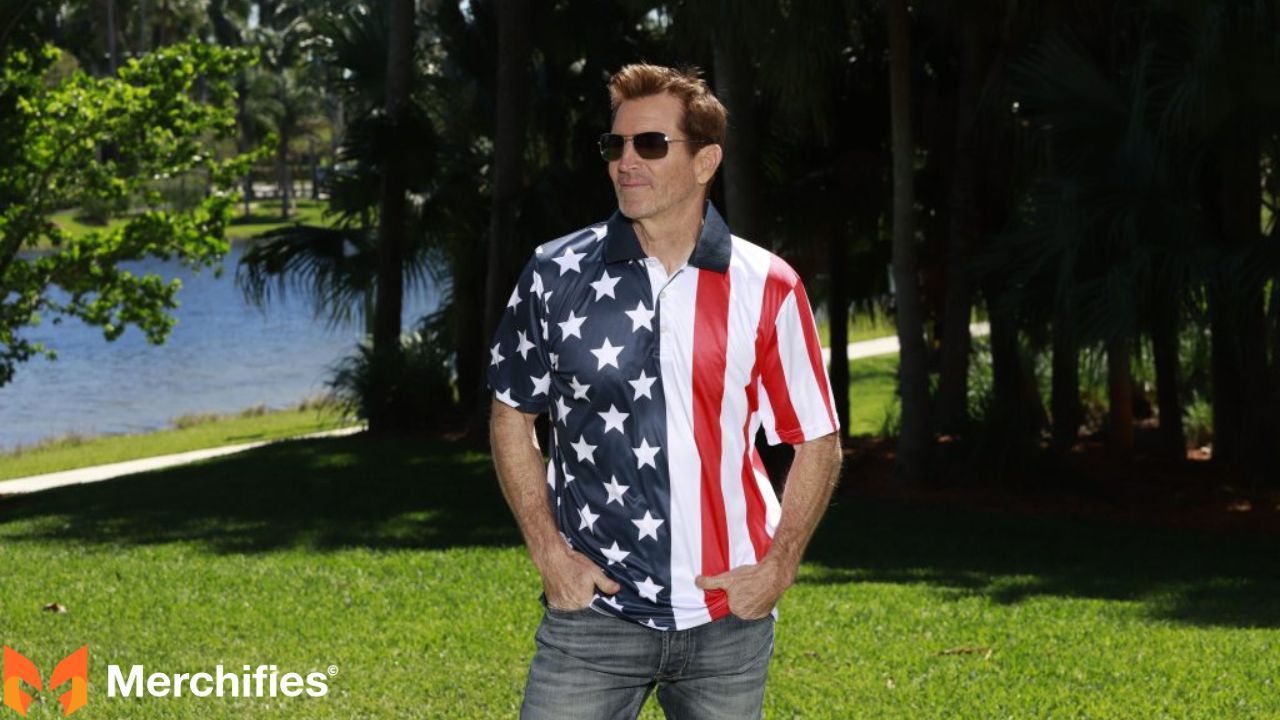
For Veterans
Visibility. Veterans feel invisible in civilian life. Military identity disappears without uniform. Veterans Day shirts restore visibility. The shirt says "I served" without speaking.
Community. Veterans spot each other by shirts. Marine recognizes Marine. Airborne veteran sees Airborne wings and nods. Silent recognition creates connection in disconnected civilian world.
Pride. Service involves years of sacrifice and achievement. After separation, achievements reduce to papers in drawer. The shirt makes achievements visible. Not bragging—maintaining identity.
Memorial. Many wear shirts honoring fallen comrades. Unit casualty lists. Specific battles. "In Memory Of" with names and dates. The shirt keeps memories alive.
A Vietnam veteran wears a shirt listing 37 casualties from his unit: "Most of America forgot us. I won't forget them."
For Military Families
Shared sacrifice. Families serve through separations, moves, stress, fear. "Army Mom" or "Navy Wife" shirts acknowledge this. "My family serves too."
Pride display. Parents, spouses, children take pride in veteran's service. The shirts make pride visible.
Gold Star families (who lost loved ones) use shirts for remembrance. A Gold Star mother wears her son's name, rank, dates. When asked, she shares his story.
"This shirt is the only thing I can still do for him. I can't call him. But I can make sure people know he existed."
For Civilians
Gratitude. "Thank you for your service" is difficult to say meaningfully. A shirt displays appreciation passively. Makes internal feeling external.
Values. Wearing patriotic shirts communicates personal values. "I believe freedom, sacrifice, and courage matter." Shows priorities.
Education. Wearing shirts prompts conversations. Children ask parents. Strangers ask meanings. Raises awareness about military service.
Community. Wearing shirts at parades creates visual unity. Demonstrates collective gratitude, not just individual.
"I never served. I can't understand what veterans experienced. But I can wear a shirt showing I care."
Common Messages Decoded
"All Gave Some, Some Gave All" acknowledges universal sacrifice while honoring fallen specifically. Every service member sacrificed. Some sacrificed everything.
"Land of the Free Because of the Brave" connects freedom to military service. Freedom isn't natural—it's defended by brave individuals.
"Freedom Isn't Free" is shortest, most powerful phrase. Three words. Enormous weight. Freedom costs lives, limbs, mental health.
"Thank You For Your Service" displays general gratitude. Controversial among veterans—some appreciate it, others find it hollow.
Branch mottos carry deep meaning. "Semper Fidelis" (Marines). "This We'll Defend" (Army). Civilians wearing them should understand why they matter.
Red poppy is official Veterans Day symbol since 1920. Inspired by WWI poem "In Flanders Fields." Poppies grew on battlefields. Represents sacrifice and remembrance.
How to Wear Respectfully
Veterans: Wear your service however you choose. You earned it. Display it proudly.
Families: "Military Mom/Dad/Spouse" appropriate. Memorial shirts respected. Your sacrifice matters too.
Civilians: Support without stolen valor.
Appropriate: "Veteran Supporter," "Thank You Veterans," generic flags, red poppies, branch appreciation without rank.
Inappropriate: Rank insignia, qualification badges, combat patches, unit-specific implying you served, "Veteran" text if you didn't serve, awards.
Simple rule: If the shirt claims you did something you didn't, don't wear it. If it shows you support those who did, wear it proudly.
When to wear: Always appropriate Veterans Day, Memorial Day, July 4th, military events. Now acceptable year-round for veterans, anytime for families, everyday for civilians.
Why T-Shirts Became THE Patriotic Symbol
Six reasons explain why t-shirts specifically became America's primary patriotic garment.
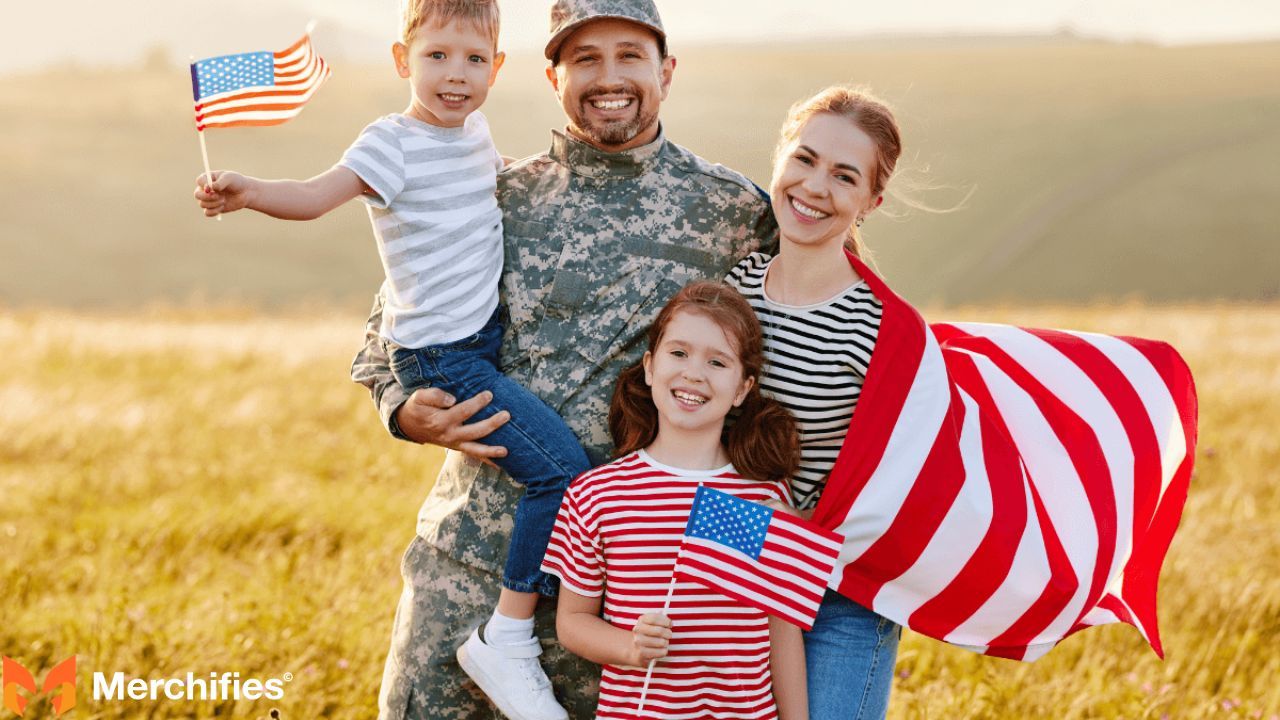
Military origins. Navy created design 1913. WWI made them visible. WWII cemented them. Veterans brought them civilian. Military invented t-shirts, now t-shirts honor military. Authentic connection other garments lack.
Accessibility. Everyone owns t-shirts regardless of income. Affordable $10-30. Available everywhere. Democratic—anyone can participate.
Visibility. Display imagery prominently on torso at eye level. Large surface area. Readable from conversation distance. In groups, coordinated shirts create visual force.
Comfort. Casual and comfortable. Fit American informal lifestyle. Work everywhere—grocery stores, gyms, parks. Enable year-round expression, not just holidays.
Canvas potential. Flat panels ideal for graphics and text. Modern printing reproduces any image full color. Artistic possibilities unlimited.
American casualness. Embody American informal culture. Rejection of formality. We wear patriotism to Walmart, not just ceremonies. Reflects broader values—equality, informality, practicality.
Europeans display patriotism through ceremonies. Americans wear it to soccer games. That difference reveals culture.
No other garment combines military heritage, accessibility, visibility, comfort, artistic potential, and cultural fit like t-shirts.
Frequently Asked Questions
How did t-shirts become a patriotic symbol?
Through military origins (Navy 1913), cultural evolution (WWI/WWII veterans), accessibility, and post-9/11 surge making them everyday wear. Military heritage gives authentic connection to patriotism.
What do Veterans Day shirts mean?
For veterans: visibility, community, pride, memorial. For families: shared sacrifice acknowledgment. For civilians: gratitude expression and values display. Different meanings for different wearers.
When did patriotic t-shirts start?
1960s Vietnam War era. Screen printing advanced enough to print flags affordably. Before this, t-shirts were underwear. Commercial industry developed 1980s-1990s.
Can civilians wear Veterans Day shirts?
Yes. Appropriate: "Veteran Supporter," "Thank You Veterans," generic patriotic symbols, red poppies. Never wear: rank insignia, qualification badges, combat patches, awards—anything claiming unearned service.
What does "All Gave Some, Some Gave All" mean?
Acknowledges every service member sacrificed something while honoring those who sacrificed everything—their lives. Balances gratitude for all with recognition of ultimate sacrifice.
Why do veterans wear military shirts?
Maintain identity, find community, display pride, honor fallen. After service, veterans feel invisible. Military shirts restore visibility saying "I served" without speaking.
What is the red poppy on Veterans Day shirts?
Official Veterans Day symbol since 1920. Inspired by WWI poem "In Flanders Fields." Red poppies grew on battlefields. Represents sacrifice, remembrance, supporting living veterans.
Are patriotic t-shirts only for holidays?
No longer. Before 9/11: three times yearly. After 9/11: acceptable year-round. Veterans wear regularly. Families wear anytime. Civilians wear showing ongoing appreciation.
What does "Freedom Isn't Free" mean?
American liberty requires ongoing sacrifice. "Cost" references lives lost, injuries, PTSD, family separations. Challenges complacency—someone paid for your comfortable life.
Should civilians thank people wearing Veterans Day shirts?
Depends on context. Many veterans appreciate sincere "thank you for your service." Others find it uncomfortable. Simple respectful gratitude usually appropriate. Listen for cues.
From Military Necessity to National Symbol
T-shirts started as Navy underwear 1913. Wars made them outerwear. Hollywood made them cool. Vietnam made them political. 9/11 made them patriotic uniform.
How did t-shirts become a patriotic symbol? Through authentic military lineage. Through evolution. Through accessibility. Through American casualness making patriotism wearable everywhere.
T-shirts became patriotic symbols because they came FROM military, were adopted BY American culture, now unite both.
Veterans Day shirts meaning varies. Veterans: visibility, community, pride. Families: shared sacrifice. Civilians: gratitude and values.
Cotton and ink. But when that cotton carries a flag, unit patch, or "All Gave Some, Some Gave All," it transforms. Becomes conversation starter. Memorial. Statement. Visible thank-you. Community identifier.
Whether veteran, family, or civilian, understand what you're wearing. That Veterans Day t-shirt connects you to centuries of tradition. That patriotic shirt links you to everyone who wore uniform. That simple cotton carries weight of sacrifice, heritage, gratitude.
Next Veterans Day, when you see parades filled with flag t-shirts, remember: those aren't just shirts. They're living history. Wearable thank-yous. Fabric connections between military and civilian America.
From Revolutionary homespun to Navy cotton to modern Veterans Day apparel, Americans always used clothing for patriotic identity.